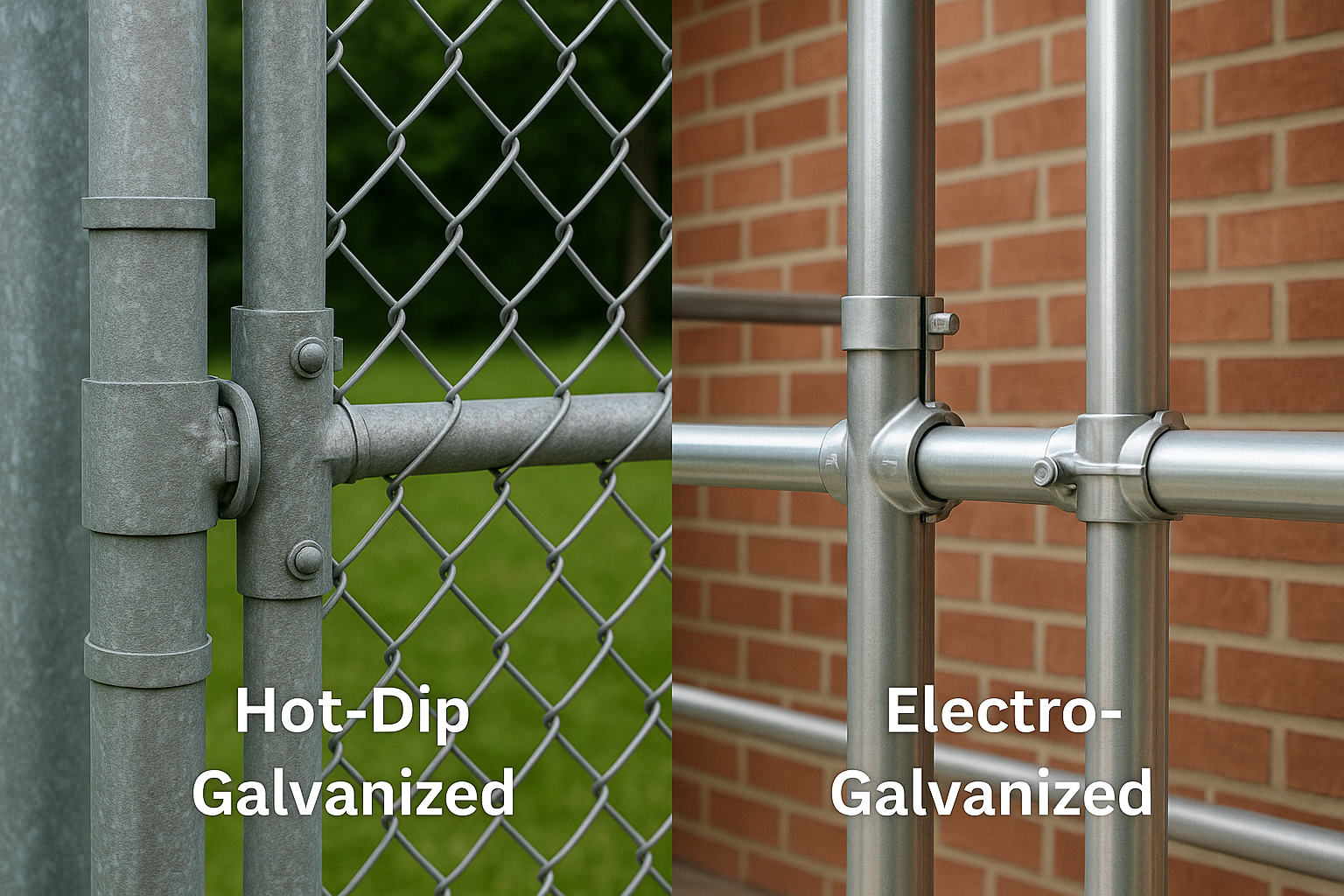Among steel products, galvanized steel pipes are widely popular due to their excellent corrosion resistance and broad range of applications. They play an indispensable role in various fields such as construction, energy, agriculture, transportation, and machinery manufacturing. In terms of galvanizing methods, there are primarily two processes: hot-dip galvanizing (Hot-dip Galvanizing) and electro galvanizing (Electro Galvanizing). Although both fall under the “galvanizing” category, they exhibit significant differences in terms of process, performance, cost, service life, and applicable scenarios.

1. Process Principle Differences: Hot-Dip vs. Electrodeposition
A. Hot-Dip Galvanizing
Hot-dip galvanizing involves cleaning the steel pipe and then immersing it in molten zinc to form a composite coating consisting of a zinc-iron alloy layer and a pure zinc protective layer on its surface. This method achieves metallurgical bonding between the zinc layer and the base material through a combination of physical adhesion and alloy reaction.
Characteristics:
Thick coating, typically 50–80 μm, with a maximum thickness exceeding 100 μm
Strong adhesion and high wear resistance
Excellent corrosion resistance, particularly suitable for outdoor or harsh environments
B. ElectroGalvanizing (Electro Galvanizing)
Electro Galvanizing involves depositing a uniform, thin, and dense zinc layer on the surface of steel pipes through an electrolytic process. The process is conducted at room temperature, with the zinc layer physically bonded to the substrate. The coating thickness is relatively thin, typically 5–30 μm.
Features:
Smooth and delicate coating with an aesthetically pleasing surface
Thin zinc layer, suitable for interior applications or light industry with high surface precision requirements
Weaker adhesion, inferior impact resistance and corrosion resistance compared to hot-dip galvanizing
2. Performance Comparison
| Item | Hot-Dip Galvanizing | Electro Galvanizing |
| Coating Thickness | 50-100 μm | 5-30 μm |
| Corrosion Resistance | Excellent (service life 15-30 years) | Average (service life 3–8 years) |
| Adhesion and wear resistance | High, suitable for heavy-duty applications | Moderate, prone to peeling |
| Surface finish | Average, may exhibit zinc flowers or roughness | Excellent, with a bright appearance |
| Application environment | Outdoor, heavy industry, corrosive environments | Indoor, light industry, areas with high aesthetic requirements |
| Cost | Relatively high (but good cost-effectiveness) | Low cost, suitable for short-term use |
| Processing Complexity | High, involving acid washing, pre-treatment, drying, etc. | Low, suitable for continuous production |
3. Application Scenario Analysis
A. Hot-Dip Galvanized Steel Pipe
a. Suitable Environments:
Outdoor environments
Humid, high salt fog, highly corrosive environments
Long-term structural requirements
Heavy-duty or high mechanical stress environments
b. Typical Application Fields
| Construction Engineering | Stair railings, scaffolding, canopy structures, building support pipes |
| Municipal Facilities | Streetlight poles, guardrails, traffic sign supports, manhole cover fences |
| Power and Telecommunications | Cable trays, communication towers, substation structural components |
| Agricultural Facilities | Greenhouse frames, livestock fences, irrigation systems |
| Infrastructure | Bridge structures, steel trestles, railway supports, water conservancy facilities |
| Petrochemical | Oil and gas pipelines, chemical support pipelines, Valve matching pipe |
| Marine Engineering | Port guardrails, floating bridge supports, coastal structure supports |
c. Features and Advantages
High corrosion resistance, lifespan over 15 years
Thick coating with strong adhesion, capable of withstanding impact and wear
Suitable for maintenance-free or hard-to-maintain environments
B. ElectroGalvanized Steel Pipe
a. Suitable Environments
Indoor use
Dry, clean environments with aesthetic requirements
Structures with low load or decorative applications
b. Typical Application Areas
| Industry | Application Examples |
| Interior decoration | Ceiling suspension rods, light steel studs, electrical conduits, decorative structures |
| Furniture manufacturing | Display racks, furniture frames, coat racks, warehouse shelves |
| Electrical equipment | Electrical cabinet frames, wiring conduits, instrument protection brackets |
| Ventilation and air conditioning | Ventilation ducts, heating and cooling ventilation brackets |
| Automotive and transportation | Automotive component brackets, bicycle frames (non-structural parts) |
| Retail and exhibitions | Display racks, portable stage structures, merchandise partition barriers |
c. Features and Advantages
Bright surface, aesthetically pleasing appearance
Low cost, suitable for large-scale production of lightweight products
Easy to process, suitable for welding, painting, and other post-processing
4. Cost and Economic Efficiency
| Comparison Items | Hot-dip galvanized steel pipes | Electro galvanized steel pipes |
| Manufacturing Cost | Slightly higher cost (higher zinc consumption) | Lower cost |
| Transportation Protection | Scratch-resistant, minimal transportation damage | Prone to scratches, requires high protection standards |
| Long-term Economic Efficiency | Less maintenance, longer lifespan | Short lifespan, requires regular replacement |
Summary: Choose electro galvanized for short-term cost savings, and hot-dip galvanized for long-term value.
5.Procurement Recommendations and Common Misconceptions
A. How to choose the type of galvanization?
| Usage Environment | Recommended Process |
| Outdoor, exposed to rain, snow, salt fog, or strong corrosion | Hot-dip galvanized |
| Indoor, lightweight structures with aesthetic requirements | Electro galvanized |
| High strength requirements, support structures | Hot-dip galvanized |
| Temporary structures | Electro galvanized |
B. Common misconceptions
Misconception 1: All galvanized steel pipes are the same — in reality, their corrosion resistance varies significantly
Misconception 2: Electro galvanized pipes look better, so they are better — do not overlook their structural and corrosion resistance limitations
Misconception 3: Hot-dip galvanized is expensive and not cost-effective — the actual service life determines the total cost
Conclusion: Although galvanized steel pipes have similar appearances, their performance, cost, and lifespan vary greatly due to different manufacturing processes. Whether hot-dip galvanizing or electro galvanizing is superior depends on the specific application. For projects prioritizing long-term durability and structural strength, hot-dip galvanizing is the clear choice; for applications requiring lightweight, aesthetic appeal, and short-term use, electro galvanizing offers better cost-effectiveness.
